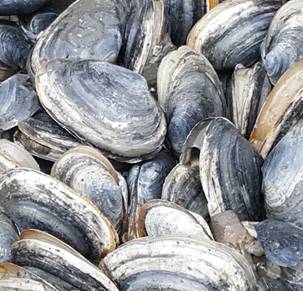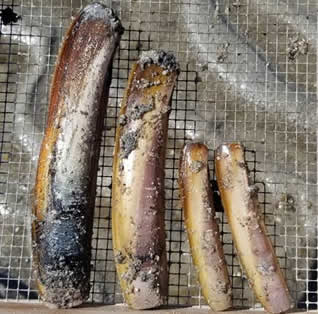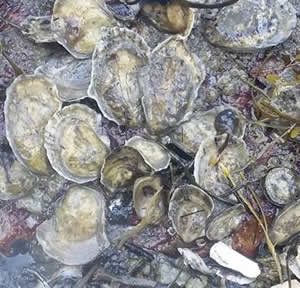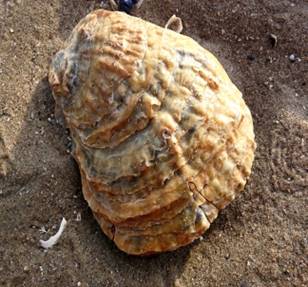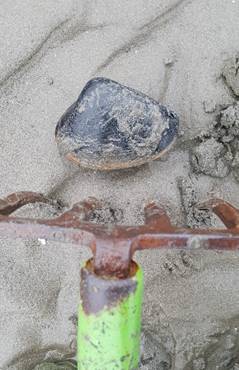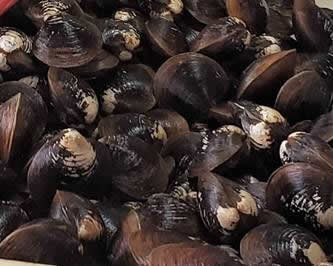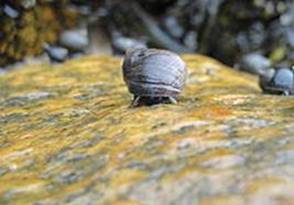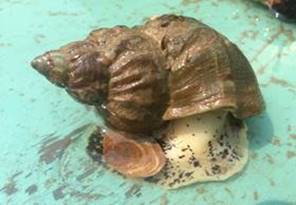| Name | Description | Size Limits | Recreational Information |
|---|---|---|---|
|
Soft Shell Clams (Mya arenaria) Other names: steamers, longnecks
Photo credit: Heidi Leighton (DMR) |
Soft shell clams are a native species that live in mud, sand and gravel intertidal areas. It takes about three to four years for a clam to grow to legal size, which is two inches (2"). Harvest season is year-round, peak is May through October. Soft shelled clams are regulated by DMR and coastal towns with a shellfish conservation ordinance. Many towns require recreational licenses which can be obtained through the town office or municipal shellfish warden. |
2-inch minimum size measured along the longest axis.
Town shellfish conservation ordinances may have more conservative minimum sizes or a maximum size limit. |
Recreational limit is 1 peck per person daily Towns may restrict these quantities even further through their shellfish conservation ordinance.
|
|
Hard Clam (Mercenaria mercenaria) Other names: quahog, round clam, cherrystones, littlenecks,
Photo Credit: Hannah Annis (DMR) |
Hard clams are a native species found in the sand and mud habitats of the intertidal and sheltered subtidal. They are referred to by different names depending on their size. In the order of largest to smallest, these clams are called: quahogs (chowderhogs), cherrystones, topnecks, littlenecks, and countnecks. Hard clams are regulated by DMR and some coastal towns with a shellfish conservation ordinance. Many towns require recreational licenses which can be obtained through the town office or municipal shellfish warden. In the Damariscotta River, Sheepscot River, and New Meadows Lakes; there is a Vibrio Control Plan in place that closes recreational harvest from May 1st to October 31st each year |
1-inch hinge width minimum size. Hinge width is measured at the thickest part of the clam near where the shells are joined together. Town shellfish conservation ordinances may have more conservative minimum sizes or a maximum size limit. |
Recreational limit is 1 peck per person daily. Towns may restrict these quantities even further through their shellfish conservation ordinance |
|
Atlantic Razor Clams (Ensis directus) Other names: American jackknife clam
Photo Credit: Hannah Annis (DMR) |
Razor clams are a native species primarily found in shallow subtidal flats close to the shoreline. They are distinguished by their long thin shells. Razor clams are regulated by DMR and some coastal towns with a shellfish conservation ordinance. Many towns require recreational licenses which can be obtained through the town office or municipal shellfish warden. |
4-inch minimum size measured along the longest axis. Town shellfish conservation ordinances may have more conservative minimum sizes or a maximum size limit. |
Recreational limit is 1 peck per person daily. Towns may restrict these quantities even further through their shellfish conservation ordinance. |
|
American Oyster (Crassostrea virginica) Other names: eastern oyster, Virginia oyster, common oyster
Photo Credit: Hannah Annis (DMR) |
The American oyster is native to the east coast of North America. They have two rough, whitish, irregular shells. They naturally grow on oyster reefs but most of Maine's American oysters are grown on aquaculture lease sites. American oysters are regulated by DMR and some coastal towns with a shellfish conservation ordinance. Many towns require a recreational license which can be obtained through the town office or municipal shellfish warden. In the Damariscotta River, Sheepscot River, and New Meadows Lakes; there is a Vibrio Control Plan in place that closes recreational harvest from May 1st to October 31st each year. |
2 1/2 inch minimum size measured along the longest axis. |
Recreational limit is 1 peck per person daily Towns may restrict these quantities even further through their shellfish conservation ordinance. |
|
European Oysters (Ostrea edulis) Other names: flat oyster, Belons, mud oyster, edible oyster
Photo Credit: Natureinfocus.wordpress.com |
European Oysters are characterized by their rounder, flatter shell. European oysters are not native to Maine and were first grown by aquaculturists, but later established wild populations. European oysters are regulated by DMR and some coastal towns with a shellfish conservation ordinance. Many towns require recreational licenses which can be obtained through the town office or municipal shellfish warden. In the Damariscotta River, Sheepscot River, and New Meadows Lakes; there is a Vibrio Control Plan in place that closes recreational harvest from May 1st to October 31st each year. There is also a seasonal closure statewide from June 15th to September 15th. |
3-inch minimum size measured along the longest axis. |
Recreational limit is 1 peck per person daily. Towns may restrict these quantities even further through their shellfish conservation ordinance. |
|
Mussels (Mytilus edulis) Other names: common mussel
Photo Credit: Denis Nault (DMR) |
The blue mussel is a common native bivalve mollusk that lives from the intertidal zone to depths of several hundred feet and is found frequently clinging to the rocky shoreline. Mussels can be harvested all year and are regulated by DMR only, they are not regulated by towns and recreational licenses are not required. |
2 Inch Minimum |
Recreational limit is 2 bushels per person daily. |
|
Atlantic Surf Clam (Spisula solidissima) Other names: bar clam, hen clam, skimmer, sea clam
Photo Credit: Heidi Leighton (DMR) |
Surf clams also known as hen clams are very large and fast growing clams which can grow to 8 inches or more and weigh over a pound. They live burrowed into the sand beneath the turbulent waves of the surf breaker zone. Surf clams are regulated by DMR and some coastal towns with a shellfish conservation ordinance. Many towns require a recreational harvest license which can be obtained through the town office or municipal shellfish warden. |
No size limit |
The recreational harvest limit is 3 bushels per person daily. Towns may restrict these quantities even further through their shellfish conservation ordinance. |
|
Mahogany Quahog (Arctica islandica) Other names: ocean quahog
Photo Credit: David Miller (DMR) |
Mahogany quahogs are small hard shelled clams that are harvested from Maine's subtidal waters. Mahogany quahogs are fished for by vessels with bottom drag gear and regulated by DMR and the National Marine Fisheries Service. |
1-inch hinge width minimum size. Hinge width is measured at the thickest part of the clam near where the shells are joined together. |
The recreational harvest limit is 3 bushels per person daily. |
|
Common Periwinkle (Littorina littorea)
Photo Credit: Wikipedia |
The common periwinkle is the most common intertidal snail. Common Periwinkles grow to 11/4 inches in length. |
Minimum size is determined by a numerical count. If a one quart sample contains more than 220 periwinkles, they are considered undersize. |
The recreational harvest limit is 2 quarts per person daily. |
|
Waved Whelk (Buccinum undatum) Other names: northern whelk, edible whelk, European whelk
Photo Credit: Gulfofme.com |
Waved whelks are medium sized with both axial and spiral ridges on their shell. Adult waved whelks are two to four inches in length and are found sub tidally. |
Legal size is 21/2 inches shell length |
The recreational harvest limit is 1/2 bushel of whelks per person daily. |
